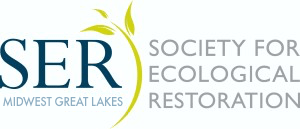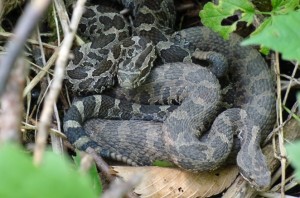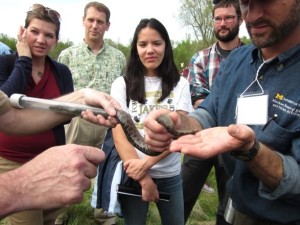HELPING MICHIGAN’S ONLY VENOMOUS SNAKE
“You do what?!” people ask me after I tell them I work to protect rattlesnakes and their habitats. When I explain that it is the eastern massasauga rattlesnake (Sistrurus catenatus), which is a species of special concern whose population in the Midwestern United States and Ontario has been declining for the past hundred years – the question that follows is usually “isn’t that a good thing?” For many people a declining rattlesnake population may bring a sense of relief. However, there are many reasons why having a healthy eastern massasauga population is intrinsically related to a vital, balanced ecosystem. The eastern massasauga is very different from the horrifying portrayals of snakes found in the popular media. This rattlesnake is a small, slow, and timid creature that prefers quiet basking and peace, and only strikes in self-defense or to capture prey. Its presence is vital because it keeps vole populations in check and it provides food for many other animals, such as herons, foxes, and owls. The eastern massasauga is considered a keystone species by the U.S Fish and Wildlife Service because the presence of a small number of these rattlesnakes has a significant impact on the rest of the food chain.
The eastern massasauga was listed as a federal candidate species in 1999, which prompted important funding initiatives to implement conservation efforts to safeguard this species. Habitat degradation and loss have been identified as the primary threat to the eastern massasauga. In 2010, a two-year project with the Ecological Consulting Group began to assess the population of eastern massasauga at the University of Michigan’s Matthaei Botanical Gardens. During the first season of sampling 13 eastern massasaugas were captured at Matthaei Botanical Gardens and marked. Eight of the thirteen rattlesnakes captured in the first season were gravid females. The second season of sampling documented 14 additional individuals. These initial findings suggested a solid population and encouraged more work to benefit the eastern massasauga population at Matthaei Botanical Gardens.
In 2011, the Sustain Our Great Lakes grant program administered by the National Fish and Wildlife Foundation awarded the Matthaei Botanical Gardens a two year grant to initiate restoration of eastern massasauga habitat on over 1.01 km2 of critical habitat and to provide conservation education activities related to these restoration efforts. The goal of this project was to restore ecological integrity to eastern massasauga habitat by controlling exotic invasive plant species and encouraging native flora. Working with student interns from the University of Michigan as well as a great volunteer base from the University and wider community, we have focused our restoration efforts primarily on removal of invasive plants, controlled burns, and native seed collection and dispersal. Educating our staff, students, volunteers, and the public through presentations, literature, media coverage, and interpretive signs throughout the Matthaei Botanical Gardens property has also been key components in our restoration approach to benefit this eastern massasauga population.
It may seem counterintuitive, but fire has historically been an important component to restoring eastern massasauga habitat. Decades of invasive plant growth and wildfire suppression within the Matthaei Botanical Gardens have made much of the available habitat less suitable for these rattlesnakes. Thick stands of buckthorn, honeysuckle, and privet have crowded the riparian zones of Fleming Creek, producing shade and reducing the diversity and abundance of native plants. One main goal of our project was to reintroduce fire to eastern massasauga habitat to help reduce shrub coverage. Staff and volunteers conducted prescribed burns on over 0.11 km2 during the spring burn seasons of 2012 and 2013. To avoid fire-related snake mortality we conducted prescribed burns in the early springtime before the ground has thawed or before mid-March when the eastern massasauga begins to emerge from hibernation. Similarly, the fall burn season usually starts in mid-November after several hard frosts have occurred to ensure the eastern massasauga are in or near their winter hibernacula.
The important thing about restoration of the eastern massasauga habitat is that this work directly benefits a great number of other native plants and animals found at the Matthaei Botanical Gardens. We have removed more than 0.16 km2 of invasive shrubs from prairie fen and sedge meadow habitat and have seen large buckthorn thickets transformed into diverse native plant communities. Additionally, more than 757 liters of native plant seed were collected during the project as part of our volunteer workdays and we spread over 379 liters of native plant seed on the grounds of the Matthaei Botanical Gardens as part of our restoration efforts. Most of the collected native plant seed was spread on burned areas following the prescribed burns. Fire helps to prepare the site for the seed by removing thatch and exposing the topsoil. Other restoration sites at the Matthaei Botanical Gardens were also seeded after the removal of invasive shrubs. The unused seed remains in dry storage and is viable for our use for several years to come.
Much of the success of this project is due to the commitment of many volunteers in the labor-intensive task of removing exotic invasive plants. We have tallied over 1800 hours of volunteer time through University of Michigan Law School student workdays, bimonthly Ford Crew volunteer workdays, weekly workdays with the Washtenaw County Sheriff work-program, and monthly public volunteer eco-restoration workdays joined by numerous University of Michigan student groups. Volunteers add energy and enthusiasm to our work and are always eager to learn more about how their efforts contribute to our long-term restoration goals. Many of the Washtenaw County Sherriff work-program attendees have never ventured into the ‘woods’ before, let alone cutting down a tree with a saw in hand. Often, volunteers find the work so rewarding that they ask if they can get a job here!
Weather anomalies have been a challenge for our restoration efforts. In the fall of 2012 and 2013, we had periods with too much rain and early accumulation of snow that led to wet conditions that prevented successful prescribed burns. Also, during the winter of 2012 the ground never froze enough for us to access the two prairie fens on the Matthaei Botanical Gardens for invasive shrub control without risk of disturbing the fen’s fragile soils. These two prairie fens are our highest priority sites because they have very high plant diversity and are primary eastern massasauga habitat. This work was postponed for over a year and we were forced to move our restoration efforts to lower-quality sites. Another goal of our project was to plant 150 disease-resistant American elms of three varieties to restore historical floodplain tree cover and hydrology within the Fleming Creek floodplain. These American elm tree saplings were planted during the fall of 2011 and spring of 2012. Unfortunately, the summer of 2012 turned out to be unusually hot and dry, and as result we found that only 40 of the 150 elms had survived the following growing season.
Much of our restoration efforts have focused on removing invasive plants and reestablishing native plants at the Matthaei Botanical Gardens. We have observed that eastern massasaugas frequently occur and appear to thrive in the grassy field west of the parking lot of the Matthaei Botanical Gardens. This area is dominated by the naturalized Eurasian bluegrasses Poa compressa and Poa pratensis. Prairie habitats composed of these cool-season Eurasian grasses provides canopy cover that provides snakes with concealment from avian predators and canopy openings that provide snakes with sunlight for basking. These prairie habitats dominated by cool season grasses also provides habitat for the meadow vole (Microtus pennsylvanicus), which is the primary food source of the eastern massasauga. While this field is lacking in native plant diversity, it does serve an important role in providing valuable habitat for the eastern massasauga. So this presents us with a restoration dilemma. Since this non-native habitat appears to benefit eastern massasaugas – do we leave it alone? Or do we attempt to shift the plant community within this field from non-native plants to native plants? If so, how do we do so without impacting the snakes?
In May of 2012 our organization was fortunate to host the 2012 Midwest-Great Lakes SER Chapter’s Annual Meeting and our restoration project was featured within the Joint Plenary Session and Matthaei Botanical Gardens Tour. More than 100 people were in attendance for this plenary session that was titled Conservation and Restoration of Eastern Massasauga Rattlesnake and consisted of invited presentations from visiting scientists who conducted the eastern massasauga population surveys, staff from the Matthaei Botanical Gardens, and the eastern massasauga project manager. After the plenary session attendees were given a tour of the Matthaei Botanical Gardens. The obvious highlight of the tour for many attendees was the opportunity to see and touch an eastern massasauga. Later that summer we hosted a second workshop that was free and open to the public, which drew over 50 people from the local area. These and two other workshops were well received, which was very encouraging to those of us working on the project. The attendance and interest of participants indicated that people from the community, students, faculty, scientists, and other natural resource managers were all very interested and supportive of our efforts. At each workshop we handed out a booklet with information about the eastern massasauga and recommended management techniques. Many of our partners were also participants at our workshops and group discussions and frequently shared information and ideas related to their own experience. These events helped to keep us connected and engaged with our partners and improve our ability to work together on future projects.
The experience obtained and the lessons learned over the course of this restoration project have positioned us to achieve our goal of maintaining a healthy and stable eastern massasauga rattlesnake population. We will need to continually evaluate and adapt our management activities as we seek to restore integrity to the ecosystems and habitats found on our property.
One of the most frequently asked questions that I and the other Matthaei Botanical Gardens staff receive is “how many massasaugas are here at Matthaei Botanical Gardens?” While we may never know the exact number of snakes, the current population estimate is between 32 to 50 individuals based on information derived from the population assessment provided by Ecological Consulting Group. We also have evidence that eastern massasaugas are reproducing at the Matthaei Botanical Gardens, as shown in this video of a pair of eastern massasaugas found in a mating ritual at the Matthaei Botanical Gardens (vimeo.com/63322273). Evidence of reproducing rattlesnakes is inspiring because it suggests the promise of good things to come for the future generations of eastern massasauga at Matthaei Botanical Gardens.
Steven Parrish,
Matthaei Botanical Gardens and Nichols Arboretum, University of Michigan
Email: parrishs@umich.edu



